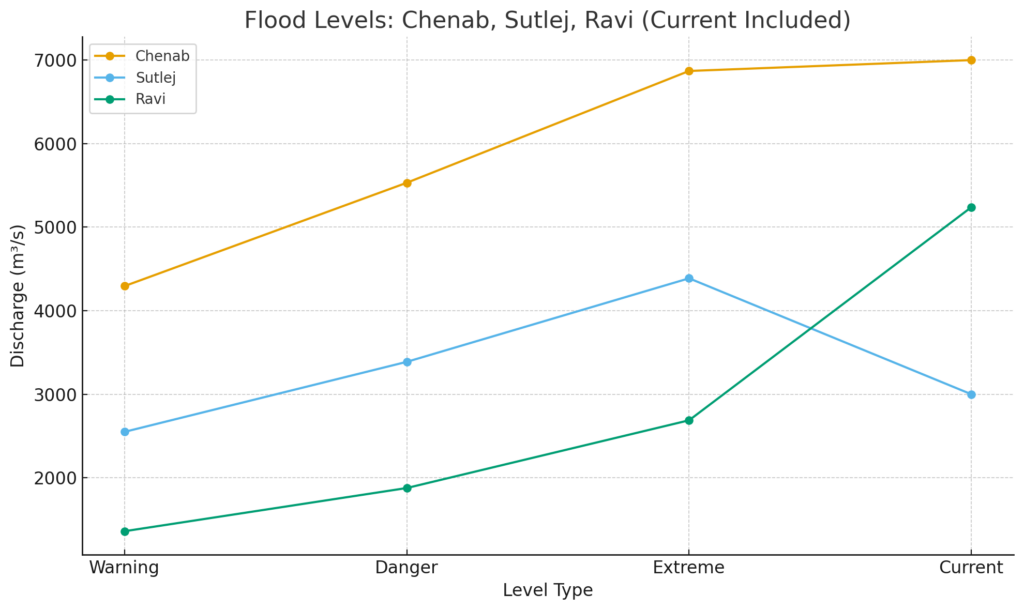Flood Safety for Car Owners: Prevent Costly Damage with These Steps
Pakistan is facing a critical flood situation. The Chenab and Ravi rivers are experiencing extremely high to exceptionally high flood levels, with water discharges reaching hundreds of thousands of cusecs.
Authorities have already evacuated thousands of people from flood-hit districts in Punjab, and warnings are in place for Qadirabad, Shahdara, and other low-lying regions.
Reports also confirm that India has released water from dams upstream, worsening the flood risk downstream in Pakistan.
We’ve created this graph for you to visually understand the current river levels and their severity (updated as of 1:05 PM, 28th August, 2025):

-
Chenab River – Currently at ~7,000 m³/s, which is above the extreme flood level.
-
Sutlej River – Flow is around 3,000 m³/s, between the danger and extreme thresholds.
-
Ravi River – Discharge has surged to ~5,238 m³/s (185,000 cusecs), far beyond the extreme flood level.
This is not just a threat to land and crops; it is also a direct threat to our homes, livelihoods, and vehicles. For many Pakistanis, a car is not just a means of transportation but an investment in life, often purchased with years of savings. That makes it essential to prepare and protect your vehicle in case your area is affected.
Why Cars Are at Serious Risk During Floods
Once floodwater enters a car, the damage to the interior, upholstery, and mechanical systems can be severe and often irreversible.
Modern cars are particularly vulnerable because they rely heavily on sensitive electronics and complex wiring. Even a few inches of water may stall the engine or cause permanent electrical failures.
In more extreme cases, attempting to restart a flooded vehicle can lead to hydrolock, a condition that can potentially wreck the engine.
To make matters worse, most standard car insurance policies in Pakistan do not cover flood damage, since it is classified as an “Act of God.” Unless an owner has opted for special comprehensive coverage, they may be required to bear the costs of repair or replacement themselves.
If Flood Enters Your Area, Do This:
If the water level begins to rise in your neighborhood, you have to accept that there is very little chance of saving the car from the flood. Once water enters, damage is almost certain.
The best step is to relocate early. As soon as you receive a flood warning, move your vehicle to higher ground, such as a multi-story parking area or a relative’s home on elevated land.
Do not wait too long. Once roads are submerged, moving the car becomes risky and may put your own life in danger.
What If There Is No Higher Ground?
In some areas, safe elevated spots may simply not exist. In that case, do these things:
- Seal the car by rolling up the windows tightly and disconnecting the battery to minimize electrical short circuits.
- Move it away from danger — try to park a safe distance from drainage channels, riverbanks, or areas where flood currents are strongest.
- Raise the car slightly using bricks, ramps, or wooden blocks. Even a few extra inches may help keep water below the engine level.
- Protect the interior by covering seats and electronics with plastic sheets and removing any valuables or important documents.
- Document the situation with photos and videos to support insurance or compensation claims later.
- Accept limitations — in a major flood, it’s about reducing damage, not preventing it entirely. Your safety should always come first.
Car Safety Do’s & Don’ts
Here’s a quick checklist of things you should do and don’t:
| Do’s | Don’ts |
|---|---|
| Prepare an Emergency Kit: Keep spare keys, important documents, and essentials away from the vehicle in case you need to evacuate. | Don’t Drive Through Floodwaters: Just 2 feet of moving water can sweep away most cars. Even shallow water can stall your engine. |
| Check Seals & Windows: Ensure doors and windows are fully closed to slow down water entry. | Don’t Start a Flooded Car: If water gets inside, starting it can cause hydrolock, permanently damaging the engine. |
| Stay Up to Date: Follow NDMA/PDMA alerts and keep track of safe routes through local updates and community forums. | Don’t Rely on Brakes Immediately: After passing through water, brakes may lose effectiveness — test them gently first. |
After the Flood: Car Maintenance Checks
If your car was exposed to floodwater, here’s a short checklist:
-
Do not try to start the car if it has been exposed to floodwater. Starting it can cause severe engine damage. Always have it towed to a trusted workshop.
-
Check all fluids at the workshop. Engine oil, brake fluid, and transmission fluid may be contaminated with water and must be replaced.
-
Replace air filters and have the entire electrical system inspected thoroughly, as water in wiring or sensors can create hidden long-term issues.
-
Disinfect and clean the interior quickly. Floodwater carries bacteria and dirt, and if left untreated, it can lead to the growth of mold and pose serious health hazards.
Conclusion
Floods are natural disasters, and when they strike, they are often inevitable. No one can completely stop the damage they bring, especially in vulnerable areas.
However, by taking the right precautions, car owners can minimize the risks and reduce the extent of damage to their vehicles.
At the end of the day, your safety always comes first — but protecting your car wisely ensures that your hard-earned investment stands a better chance against nature’s challenges.



Comments are closed.